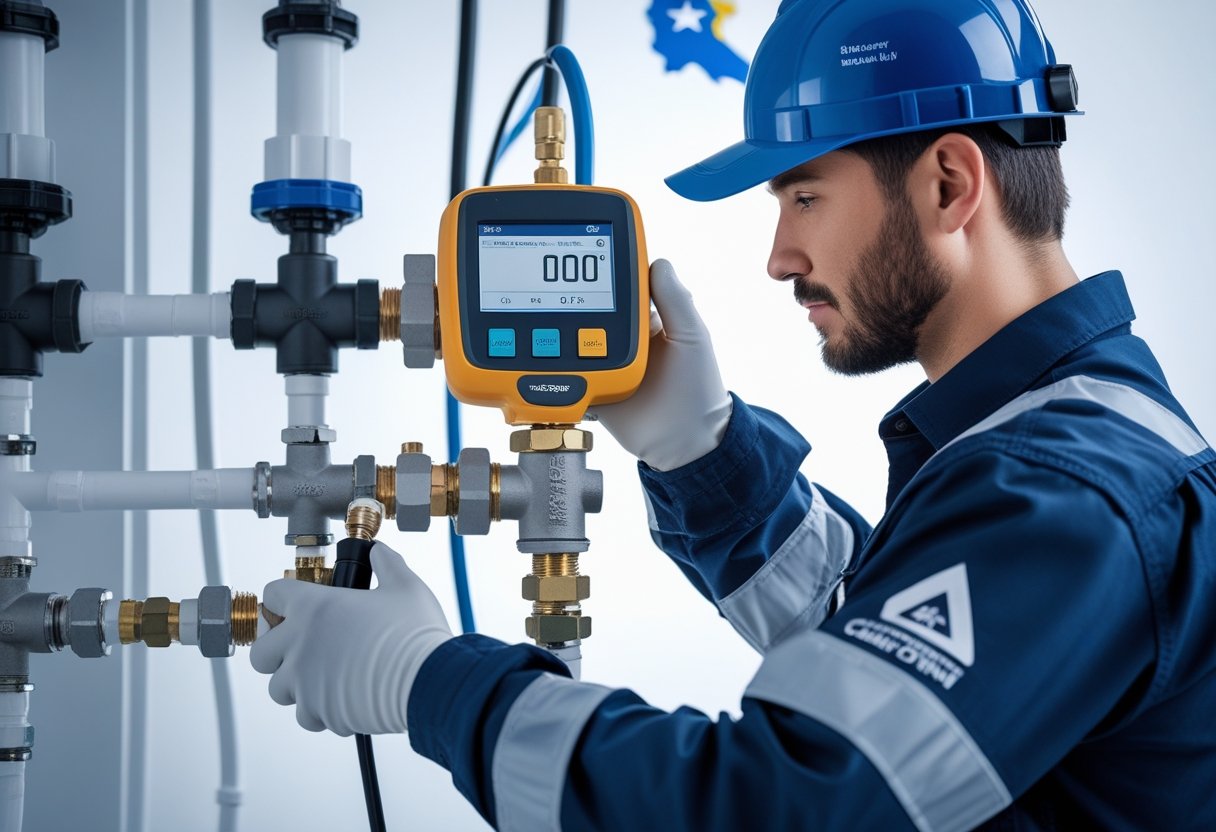Backflow contamination incidents can pose serious risks to your water supply, leading to potential health hazards for you and your community. Understanding how these incidents occur and the steps you can take to prevent them is crucial for safeguarding your drinking water. From unexpected water main breaks to faulty backflow preventers, various factors can contribute to contamination.
When backflow occurs, water can flow in reverse, mixing contaminated water with your clean supply. This can result in complaints about changes in water quality, such as unusual odors or discoloration. Pacific Backflow specializes in preventing these dangerous situations by providing essential services like reliable testing and installation of backflow preventers.
By proactively addressing these issues, you can protect your home and family from the dangers of contaminated water. Trust in Pacific Backflow’s nearly 50 years of experience serving San Diego County to keep your water supply safe and secure.
Understanding Backflow Contamination
Backflow contamination poses threats to water supplies due to unintended reversals in water flow. Comprehending the mechanics of backflow and its various types is critical for safeguarding your drinking water from contaminants.
The Mechanics of Backflow
Backflow occurs when there is a change in pressure within a plumbing system, causing water to flow in the opposite direction. This reversal can happen through a cross-connection, where potable water connects with non-potable sources. When the pressure on the outlet side exceeds that on the inlet, harmful substances like bacteria or chemicals can enter your clean water supply.
Common causes of backflow include broken pipes, water main breaks, or the sudden use of large amounts of water—such as fire hydrants or irrigation systems. This risk highlights the importance of backflow prevention devices, which safeguard water systems by ensuring flow only occurs in the proper direction.
Types of Backflow
There are two primary types of backflow: backpressure and backsiphonage.
- Backpressure Backflow: This happens when the pressure in a system rises above that of the main supply. It can occur in scenarios like boilers or pumps malfunctioning.
- Backsiphonage: This occurs when a change in pressure pulls water back through a cross-connection. Typical situations include a broken water main or heavy water use in one area causing a drop in pressure elsewhere.
Understanding these types allows you to take appropriate measures to prevent contamination. Pacific Backflow offers reliable services for testing and installing backflow preventers, ensuring your water system remains safe and compliant.
Assessing Risks to Water Systems
Understanding the various risks to water systems is essential for maintaining safe and reliable drinking water. You have to identify vulnerabilities and recognize the potential consequences of contamination to effectively protect your water supply.
Identifying Vulnerabilities
Water systems can be vulnerable due to various factors. Poorly designed plumbing systems, aging infrastructure, or insufficient backflow prevention devices can all contribute to risks. It’s vital to regularly assess these aspects to ensure the integrity of your drinking water supply.
Industrial plants also present additional risk factors. Cross-connections with hazardous substances can lead to backflow incidents. Regular inspections and rigorous testing for compliance with local regulations are necessary to mitigate these vulnerabilities.
Working with experienced service providers like Pacific Backflow can help identify weaknesses in your system, ensuring that your water supply remains safe for consumption.
Consequences of Contamination
The consequences of backflow contamination can be severe. It not only compromises the safety of the drinking water supply but can also lead to public health crises. Waterborne pathogens may cause widespread illnesses, resulting in financial losses and regulatory fines.
In industrial settings, contaminated water can disrupt operations and damage equipment. You may also face legal repercussions if contamination results from negligence. Implementing robust backflow prevention measures is crucial to avert these risks.
Regular monitoring and effective response plans are important aspects of maintaining water quality. By prioritizing these practices, you protect both your community and your infrastructure against risks associated with backflow contamination.
Prevention Measures for Backflow Contamination
Implementing effective prevention measures for backflow contamination is crucial to protecting water quality. This section outlines important strategies, focusing on the installation of backflow prevention devices and adhering to regulatory frameworks.
Backflow Prevention Devices
Backflow prevention devices are essential in safeguarding your water supply from contamination. These devices, such as reduced pressure zone (RPZ) assemblies and double-check valve assemblies, function by preventing reverse flow of water.
- Reduced Pressure Zone Assemblies – This device maintains a lower pressure on the supply side to prevent backflow. It's suitable for high-risk applications.
- Double-Check Valve Assemblies – This system uses two check valves to prevent contamination, often used in residential settings.
Regular testing and maintenance of these devices are critical. Pacific Backflow offers reliable testing services to ensure your systems perform optimally. Remember, compliant installations help you meet local regulations.
Regulatory and Best Practice Framework
Staying informed about local regulations is vital for effective backflow prevention. Most municipalities mandate annual testing of backflow devices and adherence to specific installation codes.
- Local Regulations – Understand and comply with your area's water authority requirements. Failing to comply could result in penalties or service interruptions.
- Best Practices – Implement best practices, like training staff on backflow risks and regular equipment inspections, to enhance safety.
Pacific Backflow helps simplify compliance. They manage test reporting to keep you aligned with regulations, ensuring peace of mind regarding your water supply safety. Following these frameworks minimizes the risks of backflow incidents in your system.
Case Studies of Backflow Incidents
Understanding specific case studies on backflow incidents sheds light on the challenges faced in both domestic and industrial settings. These incidents highlight the critical need for effective prevention and rapid response measures to protect water supplies.
Domestic Incidents
In residential areas, backflow incidents often stem from improper plumbing connections. A notable case involved a Seattle resident who discovered contaminated water after testing a sample. Preliminary results indicated the presence of harmful bacteria, which arose from a faulty irrigation system linked to the potable water supply.
Such incidents underscore the importance of regular monitoring and compliance with regulations. Many homeowners are unaware of backflow prevention mechanisms, which is critical for safeguarding health. Annual testing, carried out by professionals like Pacific Backflow, can identify potential issues before they escalate. This vigilance helps ensure that your water remains safe and uncontaminated.
Industrial Incidents
Industrial facilities present unique challenges due to complex plumbing systems. A common case occurred at an industrial plant where a malfunctioning backflow preventer allowed chemicals to seep into the municipal water supply. Upon detection, local health authorities initiated an immediate investigation, revealing multiple instances of contamination.
This highlights the necessity of robust backflow systems and routine maintenance in industrial settings. Effective management is essential for preventing hazardous substances from entering the water supply. Services from companies like Pacific Backflow are vital in ensuring compliance with safety regulations and conducting necessary repairs and installations. Regular inspections and swift responses are key to mitigating such risks.
Monitoring and Maintaining Water Distribution
Effective monitoring and maintenance of water distribution systems are essential for preventing backflow contamination incidents. Routine testing and the implementation of emerging technologies play crucial roles in safeguarding water quality.
Routine Testing and Maintenance
Regular testing of your backflow prevention devices is vital. Annual assessments can help ensure compliance with local regulations and confirm that your equipment functions correctly. Certified technicians at companies like Pacific Backflow perform these tests efficiently.
When a backflow preventer fails, prompt repairs or installations safeguard your water system. It's important to address any identified issues quickly to eliminate contamination risks. Besides repairs, routine maintenance involves checking for leaks, ensuring that all components are in optimal condition, and monitoring essential parameters like chlorine and pH levels.
Equipped with a well-maintained system, you can protect your community’s water supply effectively.
Emerging Technologies in Water Monitoring
Innovative technologies are shaping the future of water monitoring. Automated sensors and IoT devices enable real-time monitoring of water quality, providing immediate alerts for any anomalies. These advancements can help detect issues before they escalate, thereby enhancing safety.
Data analytics tools allow for the efficient management of water distribution systems. Detailed reports can identify trends and vulnerabilities, aiding in proactive maintenance decisions. For instance, using software that tracks historical performance can streamline compliance efforts.
Implementing these technologies can significantly improve the reliability of your water system and minimize risks associated with backflow contamination. Investing in advanced solutions will ensure your community’s water supply remains secure.
Frequently Asked Questions
This section addresses common queries about backflow contamination incidents, focusing on residential areas, medical facilities, and prevention strategies. Understanding the specifics of backflow risks can help you maintain a safe water supply.
What factors contribute to backflow incidents in residential areas?
Several factors can lead to backflow incidents in residential areas. Cross-connections between potable and non-potable water sources are common culprits. Additionally, changes in water pressure, such as during a large demand or pipe burst, can create conditions for backflow.
How can one identify a potential backflow contamination risk in a plumbing system?
To identify potential risks, look for signs of unusual water flow or pressure changes. Also, inspect your plumbing for cross-connections, especially if you have irrigation systems or hoses connected to faucets. Regularly schedule assessments by professionals to ensure your system remains safe.
What steps should be taken to prevent backflow incidents in medical facilities?
In medical facilities, it's critical to implement comprehensive backflow prevention measures. This includes installing appropriate backflow prevention devices and conducting regular testing. Training staff on the importance of maintaining clean water systems is also vital.
How do backflow prevention devices safeguard against contamination?
Backflow prevention devices function by blocking the unintended reversal of water flow. These devices are designed to create a barrier, ensuring that contaminated water does not enter the clean water supply. Regular testing of these devices is necessary to maintain their effectiveness.
What are the legal ramifications for failing to prevent backflow contamination?
Failing to prevent backflow contamination can lead to severe legal consequences, including fines and liability for health-related incidents. Compliance with local regulations is essential, as violations can result in significant repercussions.
Which methods are most effective for testing backflow prevention systems?
Effective testing methods include visual inspections and pressure tests to ensure that backflow prevention devices are functioning correctly. Regular annual testing by certified professionals, such as those from Pacific Backflow, can help you remain compliant and safeguard your water supply.











